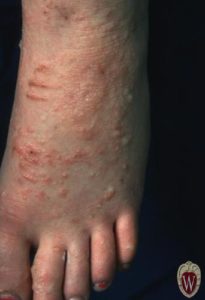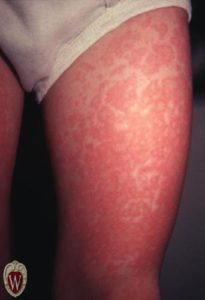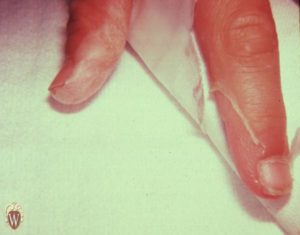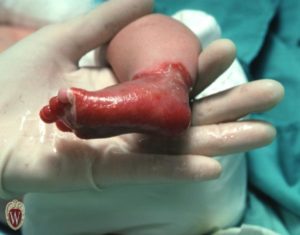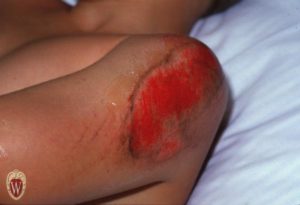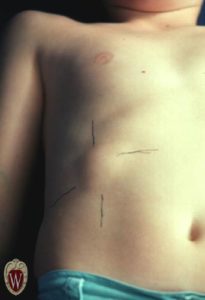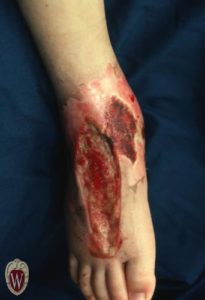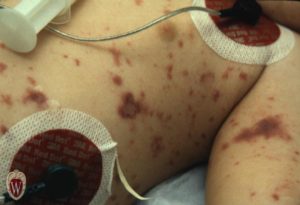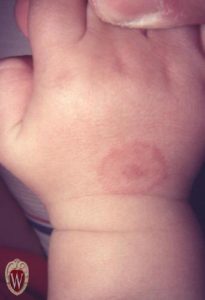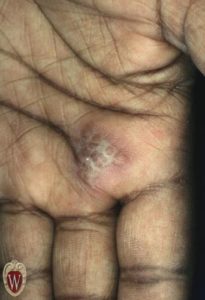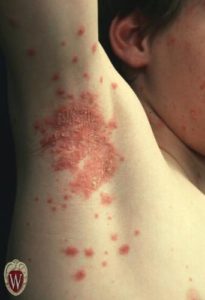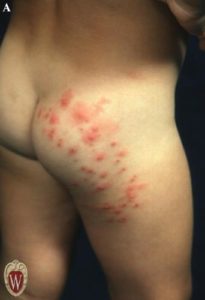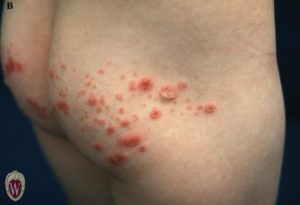Welcome to the dermatology quiz on the nomenclature of skin lesions. Below you will be given a series of photographs along with a question you must answer for each picture.
Click any of the images below to view them in a higher resolution.
This is an accordion element with a series of buttons that open and close related content panels.
View Answer
She has papules and vesicles, some of which are in a linear array. This patient has poison ivy dermatitis.
This is an accordion element with a series of buttons that open and close related content panels.
View Answer
She has the macular, reticular rash of erythema infectiosum (fifth disease).
This is an accordion element with a series of buttons that open and close related content panels.
View Answer
This is an example of desquamation. In this case, the patient had toxic shock syndrome and had peeling in the recovery phase.
This is an accordion element with a series of buttons that open and close related content panels.
View Answer
The patient has extensive erosions.
This is an accordion element with a series of buttons that open and close related content panels.
View Answer
He has an abrasion. Incidentally, in the event that the bits of asphalt and grit that are evident in the abrasion are not removed, he would, after the abrasion is healed, have a tattoo from them.
This is an accordion element with a series of buttons that open and close related content panels.
View Answer
He has a tumor; in this case a lipoma. Remember that in the morphologic sense, the term “tumor” refers to a large mass, no matter what the histologic diagnosis.
This is an accordion element with a series of buttons that open and close related content panels.
View Answer
He has a large ulcer.
This is an accordion element with a series of buttons that open and close related content panels.
View Answer
The patient has purpura. In this case, the name of the phenomenon is purpura fulminans. Please note that we have seen another patient with meningococcemia who had a somewhat different lesion–an eschar. Although both patients had the same diagnosis and disease process; the exact skin findings that we have shown are somewhat different.
This is an accordion element with a series of buttons that open and close related content panels.
View Answer
This is an iris or target lesion.
This is an accordion element with a series of buttons that open and close related content panels.
View Answer
This 7-year-old girl has clustered vesicles.
This is an accordion element with a series of buttons that open and close related content panels.
View Answer
This boy has psoriasis. He has a papulosquamous rash, with one large scaly plaque and smaller guttate lesions (papules) nearby.
Bullous impetigo is characterized by the presence of thin-roofed bullae and vesicles with abundant erosions. Herpes zoster (varicella zoster) is characterized by the presence of vesicles and papules that follow the course of a dermatome. One of these 2-year-old boys has herpes zoster, one has bullous impetigo. Which patient has which condition?
This is an accordion element with a series of buttons that open and close related content panels.
View Answer
Patient A has herpes zoster with the vesicles following the path of the S1 dermatome down the back of his leg. The rash on patient B is bullous impetigo. He has many erosions, a few intact bullae, and as he has lesions on both buttocks; his rash is not following the course of a dermatome.
